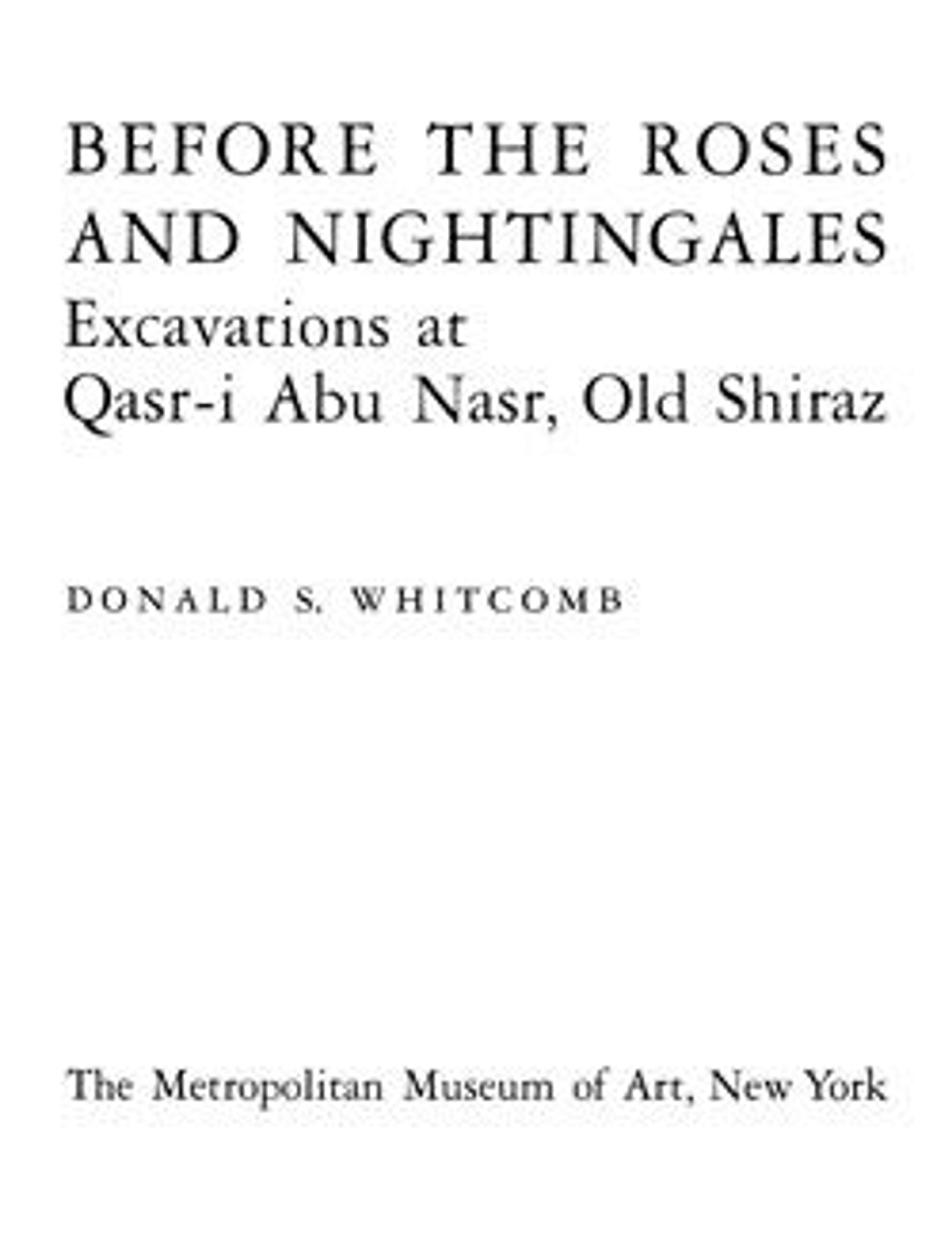Jar with Writing
This jar was excavated at Qasr-i Abu Nasr, an archaeological site now attached to modern Shiraz in southern Iran. The small town and fortress were located at a strategic point at the intersection of protective mountains, water sources, and along roads entering the plain. The site was occupied, at least intermittently, from the Parthian period (3rd century B.C.–3rd century A.D.) to the Muzaffarid period (13th–14th century A.D.). The major occupation, including the extensive fortress, dates to the Late Sasanian period (6th–7th century A.D.).
The site was excavated by archaeologists from The Metropolitan Museum of Art for three seasons from 1932–1935, enticed by the presence of standing monumental doorways of the Achaemenid period (550–330 B.C.). Research was focused mostly on the site’s pre-Islamic remains, even though the material evidence confirmed the continued occupation in the Islamic period.
The excavation revealed that the Achaemenid doorways were architectural spolia that had been taken from Persepolis, the royal site that is located about 50 kilometers to the northeast, to erect a new structure at Qasr-i Abu Nasr, most likely in the tenth century. The practice of using earlier building materials, especially from such a highly symbolic place as Persepolis, reflects the specific interest of the local Buyid rulers (945–1055) who sought to legitimize their presence through associations with the imperial past of their region, Fars. Historical and numismatic sources of the time inform us that the town was a textile manufacture center and had an active mint. The building, around which a cemetery seems to have developed, most likely functioned as a shrine up to the 15th century.
This double-handled jar bears inscriptions in black ink, written vertically to cover the entire vessel’s body. Although difficult to decipher, the inscriptions seem to repeat similar phrases, possibly with the formula basmala (in the name of God), a pattern that recalls the apotropaic writings on earlier bowls and on Islamic-period magic and talismanic devices in a variety of media. The jar was found together with a similar example (33.175.177) near the Buyid-period building. If this was indeed a shrine, and if the finding location relates to the jars’ use, it is tempting to suggest that the devotional use of the space was connected to the function of these magic vessels.
The site was excavated by archaeologists from The Metropolitan Museum of Art for three seasons from 1932–1935, enticed by the presence of standing monumental doorways of the Achaemenid period (550–330 B.C.). Research was focused mostly on the site’s pre-Islamic remains, even though the material evidence confirmed the continued occupation in the Islamic period.
The excavation revealed that the Achaemenid doorways were architectural spolia that had been taken from Persepolis, the royal site that is located about 50 kilometers to the northeast, to erect a new structure at Qasr-i Abu Nasr, most likely in the tenth century. The practice of using earlier building materials, especially from such a highly symbolic place as Persepolis, reflects the specific interest of the local Buyid rulers (945–1055) who sought to legitimize their presence through associations with the imperial past of their region, Fars. Historical and numismatic sources of the time inform us that the town was a textile manufacture center and had an active mint. The building, around which a cemetery seems to have developed, most likely functioned as a shrine up to the 15th century.
This double-handled jar bears inscriptions in black ink, written vertically to cover the entire vessel’s body. Although difficult to decipher, the inscriptions seem to repeat similar phrases, possibly with the formula basmala (in the name of God), a pattern that recalls the apotropaic writings on earlier bowls and on Islamic-period magic and talismanic devices in a variety of media. The jar was found together with a similar example (33.175.177) near the Buyid-period building. If this was indeed a shrine, and if the finding location relates to the jars’ use, it is tempting to suggest that the devotional use of the space was connected to the function of these magic vessels.
Artwork Details
- Title: Jar with Writing
- Date: 8th–10th century
- Geography: Found/excavated Iran, Qasr-i Abu Nasr
- Medium: Earthenware; unglazed, painted on greenish white slip
- Dimensions: H. 5 1/2 in. (14 cm)
Diam. 4 1/4 in. (10.8 cm) - Classification: Ceramics
- Credit Line: Rogers Fund, 1933
- Object Number: 33.175.178
- Curatorial Department: Islamic Art
More Artwork
Research Resources
The Met provides unparalleled resources for research and welcomes an international community of students and scholars. The Met's Open Access API is where creators and researchers can connect to the The Met collection. Open Access data and public domain images are available for unrestricted commercial and noncommercial use without permission or fee.
To request images under copyright and other restrictions, please use this Image Request form.
Feedback
We continue to research and examine historical and cultural context for objects in The Met collection. If you have comments or questions about this object record, please complete and submit this form. The Museum looks forward to receiving your comments.
